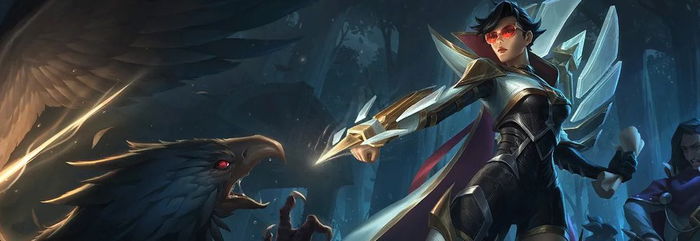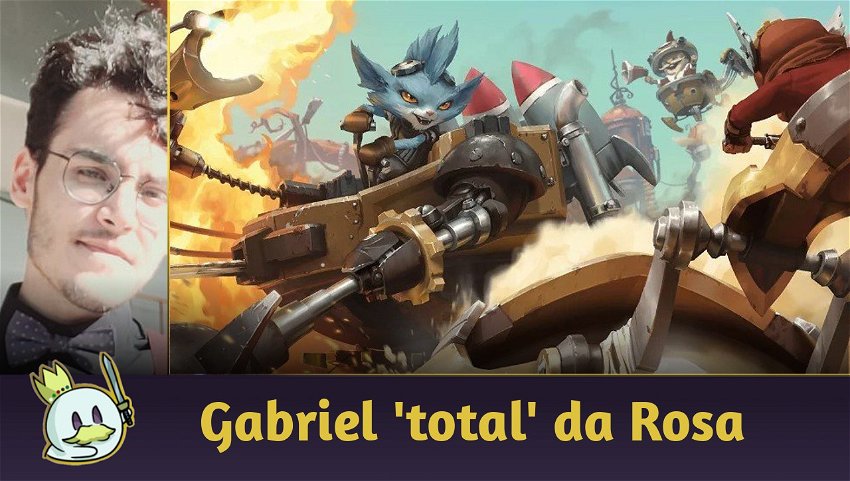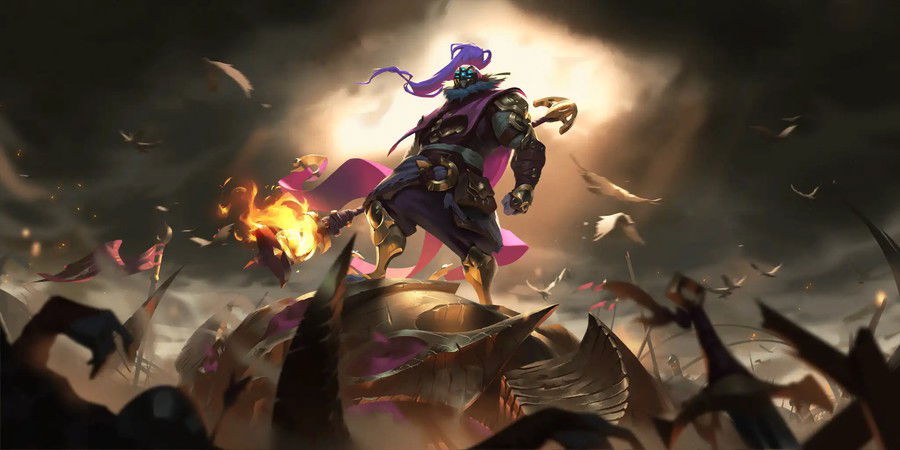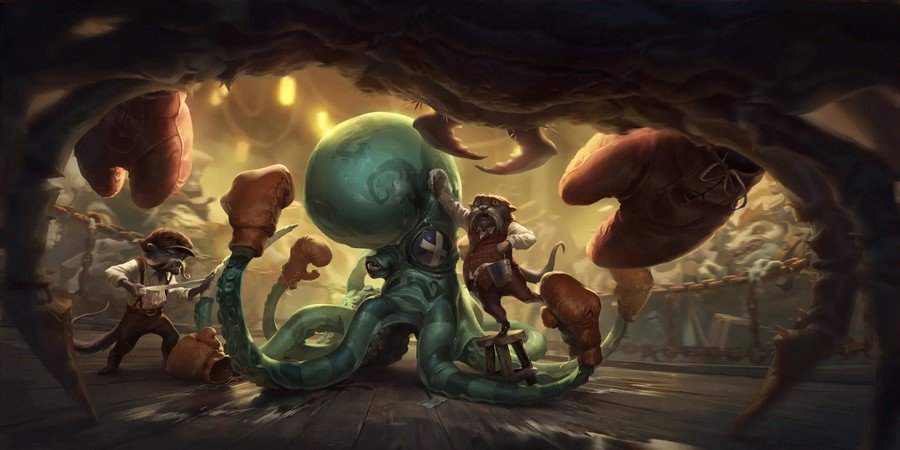Introduction

In this article, besides learning how to play Rumble Vayne, we'll also discuss Mulligan, because we can't talk about this list without approaching the "Mulligan" subject, as a great portion of this deck's strategy is based on understanding how card draw probabilities work in LoR.
Let's learn the magic behind one of the most interesting lists in all Legends of Runeterra together.
What is Mulligan?
This is a very recurring question in the card game community, and particularly new players have this question. Mulligan refers to the initial game phase, in which the first cards in your initial hand are presented, and you can switch or not these cards. In LoR, you start the game with 4 cards in hand and can exchange each of them at least once.
However, there is a detail: In Runeterra, the 4 cards that show up in your initial hand, when they're switched in Mulligan, go to a special pile we'll call "excess pile".
The "excess pile" isn't shuffled in your deck until your first draw. That is, in case you only have one copy of a card, and it shows up in your initial hand, if you exchange this card in your Mulligan, it won't show up again in your hand after the Mulligan, because it is now in the "excess pile". This card only comes back to show up in your hand again when the first round starts, and you make your first draw.
You can even receive the same card in your initial hand after the Mulligan, but that only happens when you have more than one copy of such a card. So, don't get confused, the card you received isn't the same card you threw in the "excess pile", it is just another copy of that card you have in your deck.
And what does that have to do with Rumble Vayne?
It so happens that this deck is extremely dependent on the champion Rumble, and as a result, you have to take on a very aggressive Mulligan approach to play this list.
To sum up: you exchange all the cards in your initial hand if you don't have Rumble. Don't be afraid to send back into your deck your Vaynes and Cataclysms. For that reason, this is the best list to explain how Mulligan and card draw work in LoR.
Numbers to consider
Knowing that the deck needs Rumble in the initial hand, I've asked some of my LoR friends to do the math regarding the draw probabilities of this champion.
— The chance of Rumble not showing up in the first 4 cards. = 72,27%.
— The chance of Rumble not showing up in the new 4 Mulligan cards. = 69,47%.
— The chance of Rumble not showing up in the whole Mulligan process, considering all 8 possible cards. = 50,02%.
— The chance of at least one copy of this champion appearing in an aggressive Mulligan = 49,80%.
— The chance of you drawing at least one copy of this champion on turn 1. = 53,94%.
It can be considered that you have a chance very close to 50% of having Rumble early on in your hand, considering that you have cards that tutor this champion, and you're approaching your Mulligan Strategy aggressively, so it is quite hard to have a match in which you don't see or interact with Rumble.
Decklist
Right at the start, you realize that the whole list is built thinking of having this champion in hand. The deck's main idea is to hoard resources for him and try as much as you can to attack multiple times with Rumble in the same round.
Attention: this isn't a meta list, but... as it is an extremely fast deck, in the sense that you'll win or lose your matches very fast, this deck is even recommended for you to climb the ranked ladder. Even more so because the meta is very favorable for this deck and there aren't many lists that are ready to deal with Rumble currently.
Something important to consider about this list is: the deck is unstoppable in case you have Rumble in hand. In case you don't, you basically can't play, because your matches will always be a coin flip.
Playing with Rumble in hand
If you have Rumble in your hand until turn 4, you can celebrate - your chances of victory increased dramatically. The hardest part is now choosing which will be the three cards that you will discard.
Never play Rumble without discarding 3 cards! Spellshield is the most important keyword for this champion, and you can only have it if you discard exactly three cards from your hand. With that in mind, it is easier to say which cards you shouldn't discard, than the ones you should always discard. Here are the lists:
Cards you shouldn't discard

Cataclysm might be the most important card in the deck, outside of Rumble. It is like you're giving the Challenger keyword to your champion.
Whirling Death is a combat tool that doesn't hurt your Rumble, and it can guarantee you a few victories in case your champion has Overwhelm.
Tumble is your main Rally and board pressure tool. This card can equip your Rumble with a Great Hammers, making him practically unstoppable right at turn 4.
Cards you should always discard

Fallen Rider and the Blade Fragments are the only cards that take priority when you're discarding. Repeated cards in hand, be them Rumble or Vayne are also priority as discard fodder. Don't be afraid of discarding copies of your Rumble in case it is necessary.
Important tip: don't get attached to the cards in your hand; Rumble is better than all of them. And also don't wait to play this champion! As soon as you can, summon him.
Preparing open attacks, and forcing your opponent to lose time and tempo while trying to remove or block Rumble are also a part of this deck's strategy.
Playing without Rumble

You don't.
Jokes aside, this is when the deck gets harder to play, and the whole science behind the deck building becomes magical. To play without Rumble, you need to take on a very different stance; It is like you're preparing a perfect turn in case the champion shows up. So, it is time to create value, and hoard resources in your hand. It is the time in which your cards that create Blade Fragments shine.
It is even possible to win by applying pressure on board with your units, but it is quite uncommon for that to happen, as this list doesn't have well-thought alternative win conditions.
Besides Rumble, the card which you're always praying you'll draw is Legionary Charge, which draws you a unit with 5+ attack, and guess what, our yordle champion is the only unit in your deck with 5+ attack.
The greatest challenges for this list are your blocks. You even have blockers, but they are extremely limited. So, it is normal to sacrifice your Nexus' health points to win a few more turns with a practically full board.
Understanding Matchups
The success you'll have with this deck is based heavily on your understanding of matchups in general. There isn't a cake recipe, or a correct way of explaining how this list fits into the metagame, because it is a very volatile deck, and your victory always comes in very different ways.
As much as the list always makes use of Rumble as main win condition, you'll realize the ways in which your matches end will always be crazy and completely different match by match. That happens because this list always plays against a matchup, not a deck.
And what does this mean?
Understanding what your opponent is bringing in their list is essential. You'll need to take some time to study and understand what each deck in the game does. In the great majority of matches, a decision-making which is a bit more careful will lead you to victory, such as, for instance, not spending all your mana in one turn, so you can have resources enough to protect your Rumble from a removal you're expecting your opponent to have.
This type of hand-reading practice is an ability which you will need to have and develop throughout your competitive journey. And the Rumble Vayne deck might be one of the best lists to train that.
It is common to lose a few matches when you start playing this deck because of wrong reads, but don't worry - making mistakes is how you learn.
Understanding and Facing different archetypes
In general, your list does very well against decks that don't interact with the board or have removals. Demacia decks suffer when removing your Rumble, but they might win against you due to their fast rhythm and board filling strategy.
Control lists theoretically deal with your deck very well, but if you draw your combo early, it is possible your board pressure is enough to end the match for good on turn 4 or 5, not giving your opponent time enough to deal with your Rumble.
Every time you queue with this deck in the ranked ladder, it is a bit hard to understand who has the advantage. It might be because of that aspect that this list ends up being a dynamic experience, and is never boring to play.
Final Words

Now you know how to play Rumble Vayne, and you've also learned a bit about Mulligan!
If you liked this article, don't forget to share and comment on social media! See you next time.















— 评论 0
, 反应 1
成为第一个发表评论的人